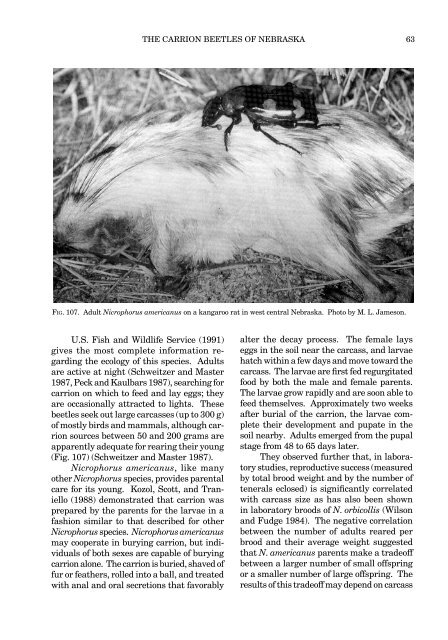Download full text - University of Nebraska State Museum
Download full text - University of Nebraska State Museum
Download full text - University of Nebraska State Museum
Create successful ePaper yourself
Turn your PDF publications into a flip-book with our unique Google optimized e-Paper software.
U.S. Fish and Wildlife Service (1991)<br />
gives the most complete information regarding<br />
the ecology <strong>of</strong> this species. Adults<br />
are active at night (Schweitzer and Master<br />
1987, Peck and Kaulbars 1987), searching for<br />
carrion on which to feed and lay eggs; they<br />
are occasionally attracted to lights. These<br />
beetles seek out large carcasses (up to 300 g)<br />
<strong>of</strong> mostly birds and mammals, although carrion<br />
sources between 50 and 200 grams are<br />
apparently adequate for rearing their young<br />
(Fig. 107) (Schweitzer and Master 1987).<br />
Nicrophorus americanus, like many<br />
other Nicrophorus species, provides parental<br />
care for its young. Kozol, Scott, and Traniello<br />
(1988) demonstrated that carrion was<br />
prepared by the parents for the larvae in a<br />
fashion similar to that described for other<br />
Nicrophorus species. Nicrophorus americanus<br />
may cooperate in burying carrion, but individuals<br />
<strong>of</strong> both sexes are capable <strong>of</strong> burying<br />
carrion alone. The carrion is buried, shaved <strong>of</strong><br />
fur or feathers, rolled into a ball, and treated<br />
with anal and oral secretions that favorably<br />
THE CARRION BEETLES OF NEBRASKA 63<br />
Fig. 107. Adult Nicrophorus americanus on a kangaroo rat in west central <strong>Nebraska</strong>. Photo by M. L. Jameson.<br />
alter the decay process. The female lays<br />
eggs in the soil near the carcass, and larvae<br />
hatch within a few days and move toward the<br />
carcass. The larvae are first fed regurgitated<br />
food by both the male and female parents.<br />
The larvae grow rapidly and are soon able to<br />
feed themselves. Approximately two weeks<br />
after burial <strong>of</strong> the carrion, the larvae complete<br />
their development and pupate in the<br />
soil nearby. Adults emerged from the pupal<br />
stage from 48 to 65 days later.<br />
They observed further that, in laboratory<br />
studies, reproductive success (measured<br />
by total brood weight and by the number <strong>of</strong><br />
tenerals eclosed) is significantly correlated<br />
with carcass size as has also been shown<br />
in laboratory broods <strong>of</strong> N. orbicollis (Wilson<br />
and Fudge 1984). The negative correlation<br />
between the number <strong>of</strong> adults reared per<br />
brood and their average weight suggested<br />
that N. americanus parents make a trade<strong>of</strong>f<br />
between a larger number <strong>of</strong> small <strong>of</strong>fspring<br />
or a smaller number <strong>of</strong> large <strong>of</strong>fspring. The<br />
results <strong>of</strong> this trade<strong>of</strong>f may depend on carcass
















